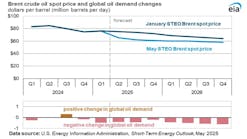Global refinery margins fall to multiyear seasonal lows in September
According to the US Energy Information Administration (EIA), global refinery margins, measured by the 3:2:1 crack spread (calculated by subtracting the price of 3 bbl of crude oil from the price of 2 bbl of gasoline and 1 bbl of distillate), have been below their 5-year averages (2019–23) since this spring, with further declines in late summer and early fall. In September, the average monthly refinery margin dropped to its lowest level for that month since 2020, when pandemic-related travel reductions significantly decreased transportation fuel demand.
Refining margins at global refineries are shrinking, indicating a decline in profitability from refining crude oil and selling petroleum products. The margins are falling because demand for petroleum products remains relatively weak despite rising global refining capacity, according to EIA.
“The recent drop in refinery margins is a departure from the past 2 years. Following the lows in 2020, decreases in US refinery capacity, and recovering petroleum product demand, supported stronger US refinery margins. This trend was particularly true on the West Coast, where several refineries closed or converted operations to renewable diesel in response to its increasing use in the region,” EIA said.
“Refinery margins have fallen in part because of relatively weak demand for petroleum products, particularly distillate fuel oil. In 2024, US product supplied of distillate fuel oil (the proxy used for consumption) averaged 6% less than in 2023 and 8% than in 2019 from June through September, mostly due to declining manufacturing activity and the increasing use of biofuels in place of conventional, petroleum-based diesel fuels on the West Coast,” EIA said.
Gasoline and jet fuel consumption in the US were slightly below 2023 levels for the same months, and they both remain 6% below 2019 levels.
Outside the US, demand for petroleum products has weakened due to slowing economic activity in China and Europe. Furthermore, the rising adoption of electric vehicles, biofuels, and LNG in trucking is gradually decreasing petroleum fuel consumption across much of Asia and Europe.
Refinery margins have also been under pressure due to new refining capacity abroad. Kuwait’s 615,000 b/d Al-Zour refinery reached full refining capacity early in 2024, Oman’s 230,000 b/d Duqm refinery has begun operations, and Nigeria’s 650,000 b/d Dangote refinery has been ramping up.
In response to low refinery margins, some global refiners have reduced runs, and some in Europe have announced plans to close or reduce capacity, according to EIA. Although planned before the recent decline in refinery margins, LyondellBasell plans to close its 264,000 b/d refinery in Houston by first-quarter 2025.

Conglin Xu | Managing Editor-Economics
Conglin Xu, Managing Editor-Economics, covers worldwide oil and gas market developments and macroeconomic factors, conducts analytical economic and financial research, generates estimates and forecasts, and compiles production and reserves statistics for Oil & Gas Journal. She joined OGJ in 2012 as Senior Economics Editor.
Xu holds a PhD in International Economics from the University of California at Santa Cruz. She was a Short-term Consultant at the World Bank and Summer Intern at the International Monetary Fund.


